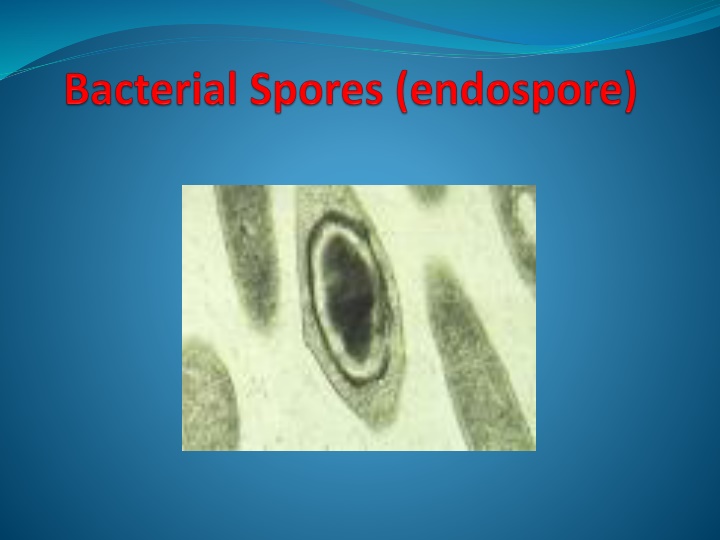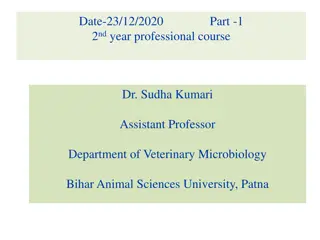
Endospores: Importance and Characteristics
Explore the significance of endospores, dormant stages of bacteria that aid survival in harsh conditions. Learn about their structure, function, and resistance mechanisms against various stressors such as heat and chemicals.
Download Presentation

Please find below an Image/Link to download the presentation.
The content on the website is provided AS IS for your information and personal use only. It may not be sold, licensed, or shared on other websites without obtaining consent from the author. If you encounter any issues during the download, it is possible that the publisher has removed the file from their server.
You are allowed to download the files provided on this website for personal or commercial use, subject to the condition that they are used lawfully. All files are the property of their respective owners.
The content on the website is provided AS IS for your information and personal use only. It may not be sold, licensed, or shared on other websites without obtaining consent from the author.
E N D
Presentation Transcript
1- This machine named a Spectrophotometer, why we use it, what is the type of measurement? 2- How many methods we use to count the bacteria, please list them? 3- What is the dilution factor, please give the equation with example?
Endospores form within the Cell Endospore is dormant stage of some bacterium that allows it to survive unfavorable conditions that would normally be lethal such as extreme drought or heat ex: Bacillus and Clostridium Endospores are resistant against; Bactericidal agents physical conditions. Low nutrient conditions Radiation High temperatures (Heat) Various chemical disinfectants 3 I
Endospores Some bacteria have the ability to form highly resistant resting stage called spores, which helps them to overcome adverse environmental conditions that are un-favorable for vegetative growth of cell. Example: when essential nutrients are depleted They are not a reproductive form and not a storage granule. The endospore is a highly resistant differentiated bacterial cell that are highly resistant to heat, and drying out and are difficult to destroy 4
Endospores The spore is a dehydrated, multishelled structure that protects and allows the bacteria to exist in suspended animation It contains a complete copy of the chromosome, the bare minimum concentrations of essential proteins and ribosomes, and a high concentration of calcium bound to dipicolinic acid. 5
The Vegetative Cell Gives Rise to One Spore Bacterial Cell Spore Bacterial Cell The endospore is able to survive for long periods of time until environmental conditions again become favorable for growth. The endospore then germinates, producing a single vegetative bacterium. 7
Endospore Function Endospores are ultimately protection for the bacterial genome Spores form within the cell and contain a full copy of the bacterial genome Endospores are not a form of reproduction, because only one new cell germinates from each spore Spores can be variable in size and location within the cell 8
Sporulation or Sporogenesis Process of endospore formation within a vegetative (parent) cell Germination = return of an endospore to its vegetative state 9
Sporulation The sporulation process begins when nutritional conditions become unfavorable, depletion of the nitrogen or carbon source (or both) being the most significant factor. Sporulation occurs massively in cultures that have terminated exponential growth as a result of such depletion. 10
Sporulation Morphologically, sporulation begins with the isolation of a terminal nucleus by the inward growth of the cell membrane. The growth process involves an infolding of the membrane so as to produce a double membrane structure whose facing surfaces correspond to the cell wall-synthesizing surface of the cell envelope. The growing points move progressively toward the pole of the cell so as to engulf the developing spore. 11
Sporulation The two spore membranes now engage in the activity synthesis of special layer that will form the cell envelope: the spore wall and cortex, lying between the facing membranes, and the coat and exosporium lying outside the facing membrane. In the newly isolated cytoplasm, or core, many vegetative cell enzymes are degraded and are replaced by a set of unique spore constituents. http://www.youtube.com/watch?v=i2m2-_YkN5Y 12
Endospores Endospores can remain dormant indefinitely but germinate quickly when the appropriate trigger is applied Endospores differ significantly from the vegetative, or normally functioning, cells 13
Some spore forming bacteria are capable of causing disease Clostridium difficile- CD Infection Clostridium botulinum botulism Clostridium perfingens gas gangrene Clostridium tetani tetanus Bacillus anthracis Woolsorter s Disease and wound infections Endospore production is associated with Gram Positive bacteria 14
Not all bacterial species can form spores Since not all bacteria form endospores, we can use this as an identification factor The Schaeffer-Fulton Stain Procedure is used to differentiate between endospores and vegetative cells 15
6/19/2017 Endospore Formation 17
Antibiotics In 1928, the British bacteriologist AlexanderFleming discovered the antibiotic penicillin. Today different antibiotics are used to interfere with different cellular processes. Because these processes do not occur in viruses, antibiotics are not effective against them. 18
Antibiotic-Resistant Bacteria Some bacteria have become resistant to antibiotics. Susceptible bacteria are eliminated from the population, and resistant bacteria survive and reproduce, thus passing on their resistance traits. Usually, if the full course of the antibiotic is administered, all the targeted bacteria are killed and there is no chance for a resistant strain to develop. If antibiotic treatment ends prematurely, some of the more-resistant bacteria may survive and reproduce 19






















